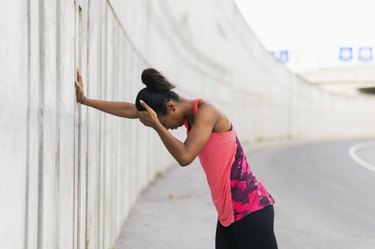
You may think that hypoglycemia, or low blood sugar, is only possible if you have diabetes. However, exercise-induced non-diabetic hypoglycemia can cause low blood sugar even if you don't have diabetes.
What's it like? Post-workout, you might feel shaky, dizzy or nauseous — your blood sugar has crashed. Here's why it happens, how to recognize the signs and the treatments that can help.
Video of the Day
Video of the Day
Read more: 10 Symptoms of Low Blood Sugar After Exercise
Sweating the Sugar
According to the American Diabetes Association (ADA), hypoglycemia — a potentially dangerous condition — is when your blood sugar falls below 70 milligrams per deciliter. And when it comes to your blood sugar, physical activity doesn't discriminate. According to the ADA, a workout lowers your blood sugar — whether you have diabetes or not — by making your body more sensitive to insulin, which can last up to a day after physical activity.
In particular, strenuous exercise can cause exercise-induced hypoglycemia, especially if that intense sweat session lasts more than an hour or two, says Amy Kimberlain, RD, LDN, a Miami-based registered dietitian and certified diabetes educator and spokesperson for the Academy of Nutrition and Dietetics. It can also happen if you neglect to eat beforehand, Kimberlain says.
Know the Signs
While symptoms vary depending on severity, according to Harvard Health Publishing, common early signs of hypoglycemia include:
- Nervousness.
- Sweating.
- Feeling cold and clammy.
- Trembling or shakiness.
- Rapid heartbeat.
- Lightheadedness.
- Hunger.
- Irritability.
The ADA includes chills, dizziness, headache and nausea as early warning signs as well. You may also feel "hangry" (aka hungry and angry), Kimberlain says.
If your low blood sugar isn't treated quickly, it can continue to fall, Harvard Medical School says, resulting in more serious symptoms like:
- Drowsiness.
- Weakness.
- Blurred vision.
- Slurred speech.
- Confusion.
- Clumsiness.
- Personality change or strange behavior (belligerence, silliness).
In the very worst case, untreated hypoglycemic episodes can result in seizures, coma or death.
What to Do: The 15/15 Rule
If you start to feel low blood sugar coming on during exercise, stop exercising. You can usually halt an exercise-induced hypoglycemic episode within moments by consuming sugar, Harvard Health says. A good rule of thumb for treating low blood sugar is the 15/15 Rule, which is when you consume 15 grams of carbohydrates in liquid or snack form and then wait 15 minutes.
Harvard Health suggests these as ideal options for getting that quick 15 grams of carbs:
- Three glucose tablets or four dextrose tablets.
- 4 to 6 ounces fruit juice.
- 5 to 6 ounces regular soda (about half a standard can).
- Five to seven pieces of hard candy from a roll of candies.
- 2 tablespoons raisins.
- Six jelly beans.
In terms of what to avoid when treating your hypoglycemic episode, Harvard Health says to skip foods with chocolate, peanut butter, nuts or fats, as fats can slow down your body's absorption of carbohydrates — limiting its ability to raise your blood sugar fast enough.
The ADA says that after your 15-minute wait, you should reassess your symptoms. If your blood sugar is still low, eat more carbohydrates, check your blood sugar (if possible) and repeat these steps until your blood sugar is 100 milligrams per deciliter at a minimum.
If this episode happened during exercise and you want to continue, the ADA advises that you take a break and ensure your blood sugar is in a safe range before resuming.
Snack Power: Prevention Is Key
Setting regular eating patterns before physical activity is key to preventing exercise-induced non-diabetic hypoglycemia, Kimberlain says. You should also think about the timing of any low blood sugar episodes. If you find you're more prone to low blood sugar in the morning, you may want to exercise at a different time of day, she says.
If you're experiencing recurring non-diabetic hypoglycemic episodes when working out and don't know why, you should consult your doctor, the ADA says.
Before seeing your doctor, try to record the specifics of your exercise and meals around your episodes. That will help your health care provider determine the cause of your lows and come up with a treatment plan for you (meal/workout timing, types of foods you eat) that'll get you back to the exercise high without the blood sugar lows, the ADA says.
- American Diabetes Association: “Hypoglycemia (Low Blood Sugar)”
- American Diabetes Association: “Blood Sugar and Exercise”
- Amy Kimberlain, RD, LDN, CDE, registered dietitian, certified diabetes educator, spokesperson, Academy of Nutrition and Dietetics, Miami
- Harvard Health Publishing: “Handling Hypoglycemia”
Is this an emergency? If you are experiencing serious medical symptoms, please see the National Library of Medicine’s list of signs you need emergency medical attention or call 911.